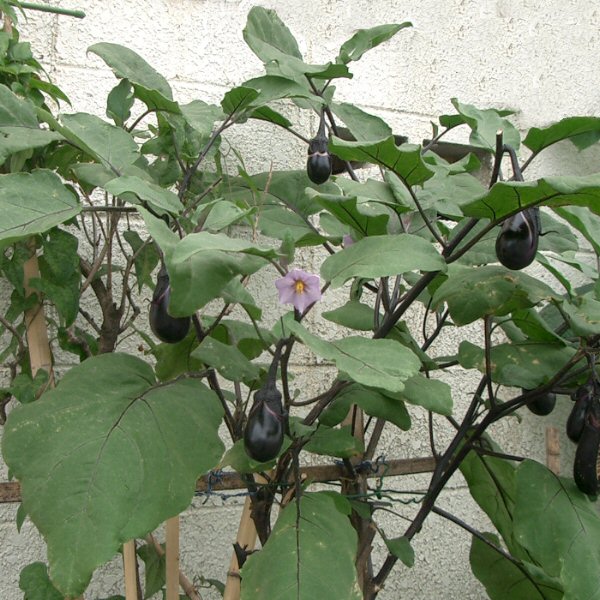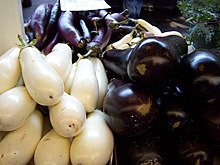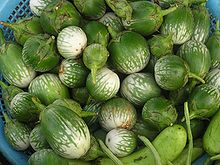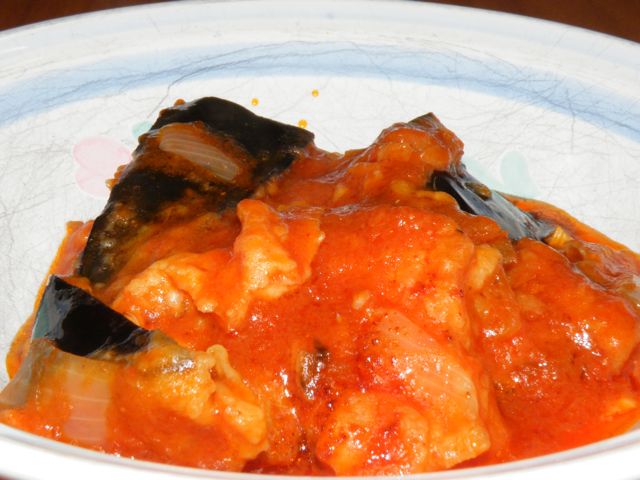 The eggplant, aubergine, melongene, brinjal, or guinea squash (Solanum melongena) is a plant of the family Solanaceae (also known as the nightshades) and genus Solanum. It bears a fruit of the same name, commonly used in cooking. As a nightshade, it is closely related to the tomato and potato and is native to Nepal, India, Bangladesh, Pakistan, and Sri Lanka.
The eggplant, aubergine, melongene, brinjal, or guinea squash (Solanum melongena) is a plant of the family Solanaceae (also known as the nightshades) and genus Solanum. It bears a fruit of the same name, commonly used in cooking. As a nightshade, it is closely related to the tomato and potato and is native to Nepal, India, Bangladesh, Pakistan, and Sri Lanka.It is a delicate perennial often cultivated as an annual. It grows 40 to 150 cm (16 to 57 in) tall, with large coarsely lobed leaves that are 10 to 20 cm (4–8 in) long and 5 to 10 cm (2–4 in) broad. (Semi-)wild types can grow much larger, to 225 cm (7 ft) with large leaves over 30 cm (12 in) long and 15 cm (6 in) broad. The stem is often spiny. The flowers are white to purple, with a five-lobed corolla and yellow stamens. The fruit is fleshy, has a meaty texture, and is less than 3 centimetres (1.2 in) in diameter on wild plants, but much larger in cultivated forms.
 The fruit is botanically classified as a berry, and contains numerous small, soft seeds, which are edible, but are bitter because they contain nicotinoid alkaloids, unsurprising as it is a close relative of tobacco. Different varieties of the plant produce fruit of different size, shape and color, though typically purple. There are even orange varieties.
The fruit is botanically classified as a berry, and contains numerous small, soft seeds, which are edible, but are bitter because they contain nicotinoid alkaloids, unsurprising as it is a close relative of tobacco. Different varieties of the plant produce fruit of different size, shape and color, though typically purple. There are even orange varieties.The most widely cultivated varieties (cultivars) in Europe and North America today are elongated ovoid, 12–25 cm wide (4½ to 9 in) and 6–9 cm broad (2 to 4 in) in a dark purple skin.
 A much wider range of shapes, sizes and colors is grown in India and elsewhere in Asia. Larger varieties weighing up to a kilogram (2 pounds) grow in the region between the Ganges and Yamuna rivers, while smaller varieties are found elsewhere. Colors vary from white to yellow or green as well as reddish-purple and dark purple. Some cultivars have a color gradient, from white at the stem to bright pink to deep purple or even black. Green or purple cultivars in white striping also exist. Chinese varieties are commonly shaped like a narrower, slightly pendulous cucumber, and were sometimes called Japanese eggplants in North America.
A much wider range of shapes, sizes and colors is grown in India and elsewhere in Asia. Larger varieties weighing up to a kilogram (2 pounds) grow in the region between the Ganges and Yamuna rivers, while smaller varieties are found elsewhere. Colors vary from white to yellow or green as well as reddish-purple and dark purple. Some cultivars have a color gradient, from white at the stem to bright pink to deep purple or even black. Green or purple cultivars in white striping also exist. Chinese varieties are commonly shaped like a narrower, slightly pendulous cucumber, and were sometimes called Japanese eggplants in North America. Oval or elongated oval-shaped and black-skinned cultivars include Harris Special Hibush, Burpee Hybrid, Black Magic, Classic, Dusky, and Black Beauty. Slim cultivars in purple-black skin include Little Fingers, Ichiban, Pingtung Long, and Tycoon; in green skin Louisiana Long Green and Thai (Long) Green; in white skin Dourga. Traditional, white-skinned, egg-shaped cultivars include Casper and Easter Egg. Bicolored cultivars with color gradient include Rosa Bianca and Violetta di Firenze. Bicolored cultivars in striping include Listada de Gandia and Udumalapet. In some parts of India, miniature varieties (most commonly called Vengan) are popular. A particular variety of green brinjal known as Matti Gulla is grown in Matti village of Udupi district in Karnataka state in India.
Oval or elongated oval-shaped and black-skinned cultivars include Harris Special Hibush, Burpee Hybrid, Black Magic, Classic, Dusky, and Black Beauty. Slim cultivars in purple-black skin include Little Fingers, Ichiban, Pingtung Long, and Tycoon; in green skin Louisiana Long Green and Thai (Long) Green; in white skin Dourga. Traditional, white-skinned, egg-shaped cultivars include Casper and Easter Egg. Bicolored cultivars with color gradient include Rosa Bianca and Violetta di Firenze. Bicolored cultivars in striping include Listada de Gandia and Udumalapet. In some parts of India, miniature varieties (most commonly called Vengan) are popular. A particular variety of green brinjal known as Matti Gulla is grown in Matti village of Udupi district in Karnataka state in India. The raw fruit can have a somewhat bitter taste, but becomes tender when cooked and develops a rich, complex flavor. Salting and then rinsing the sliced fruit (known as "degorging") can soften and remove much of the bitterness though this is often unnecessary. Some modern varieties do not need this treatment, as they are far less bitter. The fruit is capable of absorbing large amounts of cooking fats and sauces, allowing for very rich dishes, but the salting process will reduce the amount of oil absorbed. The fruit flesh is smooth; as in the related tomato, the numerous seeds are soft and edible along with the rest of the fruit. The thin skin is also edible, so peeling is not required.
The raw fruit can have a somewhat bitter taste, but becomes tender when cooked and develops a rich, complex flavor. Salting and then rinsing the sliced fruit (known as "degorging") can soften and remove much of the bitterness though this is often unnecessary. Some modern varieties do not need this treatment, as they are far less bitter. The fruit is capable of absorbing large amounts of cooking fats and sauces, allowing for very rich dishes, but the salting process will reduce the amount of oil absorbed. The fruit flesh is smooth; as in the related tomato, the numerous seeds are soft and edible along with the rest of the fruit. The thin skin is also edible, so peeling is not required.The plant is used in cuisines from Japan to Spain. It is often stewed, as in the French ratatouille, the Italian melanzane alla parmigiana, the Turkish musakka, and Middle-Eastern and South Asian dishes.
 It may also be roasted in its skin until charred, so that the pulp can be removed and blended with other ingredients such as lemon, tahini, and garlic, as in the Middle Eastern dish baba ghanoush and the similar Greek dish melitzanosalata. Grilled, mashed and mixed with onions, tomatoes and spices make the Indian dish Baingan ka Bhartha or Gojju, similar to Salata de vinete in Romania, while a mix of roasted eggplant, roasted red peppers, chopped onions, tomatoes, mushrooms, carrots, celery and spices is called Zacusca in Romania or Ajvar in Serbia and Balkans.
It may also be roasted in its skin until charred, so that the pulp can be removed and blended with other ingredients such as lemon, tahini, and garlic, as in the Middle Eastern dish baba ghanoush and the similar Greek dish melitzanosalata. Grilled, mashed and mixed with onions, tomatoes and spices make the Indian dish Baingan ka Bhartha or Gojju, similar to Salata de vinete in Romania, while a mix of roasted eggplant, roasted red peppers, chopped onions, tomatoes, mushrooms, carrots, celery and spices is called Zacusca in Romania or Ajvar in Serbia and Balkans.The fruit can also be stuffed with meat, rice, or other fillings and then baked. In the Caucasus, for example, it is fried and stuffed with walnut paste to make nigvziani badrijani. It can also be found in Chinese cuisine, braised, stewed, steamed or stuffed.
 As a native plant, it is widely used in Indian cuisine, for example in sambhar, dalma (a dal preparation with vegetables, native to Orissa), chutney, curries, and achaar. Owing to its versatile nature and wide use in both everyday and festive Indian food, it is often described (under the name brinjal) as the 'King of Vegetables'. In one dish, Brinjal is stuffed with ground coconut, peanuts, and masala and then cooked in oil.
As a native plant, it is widely used in Indian cuisine, for example in sambhar, dalma (a dal preparation with vegetables, native to Orissa), chutney, curries, and achaar. Owing to its versatile nature and wide use in both everyday and festive Indian food, it is often described (under the name brinjal) as the 'King of Vegetables'. In one dish, Brinjal is stuffed with ground coconut, peanuts, and masala and then cooked in oil.In Pakistan it is called Bengun while in Bangladesh, it is called Begun. It, along with the fish Hilsa, is used to cook a famous Bengali wedding dish. Slices of eggplant are marinated with salt and chilli powder, covered with a batter of bashone and deep-fried and eaten as a snack. This is called Beguni or Bataun or Bhata or Baigana Bhaja (In Oriya).
Health Properties
 Studies of the Institute of Biology of Sao Paulo State University, Brazil, have shown that eggplant is effective in the treatment of high blood cholesterol. Another study from Heart Institute of the University of Sao Paulo found no effects at all and does not recommend eggplant as a replacement to statins. It helps to block the formation of free radicals and is also a source of folic acid and potassium.
Studies of the Institute of Biology of Sao Paulo State University, Brazil, have shown that eggplant is effective in the treatment of high blood cholesterol. Another study from Heart Institute of the University of Sao Paulo found no effects at all and does not recommend eggplant as a replacement to statins. It helps to block the formation of free radicals and is also a source of folic acid and potassium.Eggplant is richer in nicotine than any other edible plant, with a concentration of 100 ng/g (or 0.01 mg/100g). However, the amount of nicotine from eggplant or any other food is negligible compared to passive smoking. On average, 20 lbs (9 kg) of eggplant contains about the same amount of nicotine as a cigarette.
Reference : http://en.wikipedia.org/wiki/Eggplant







0 comments:
Post a Comment